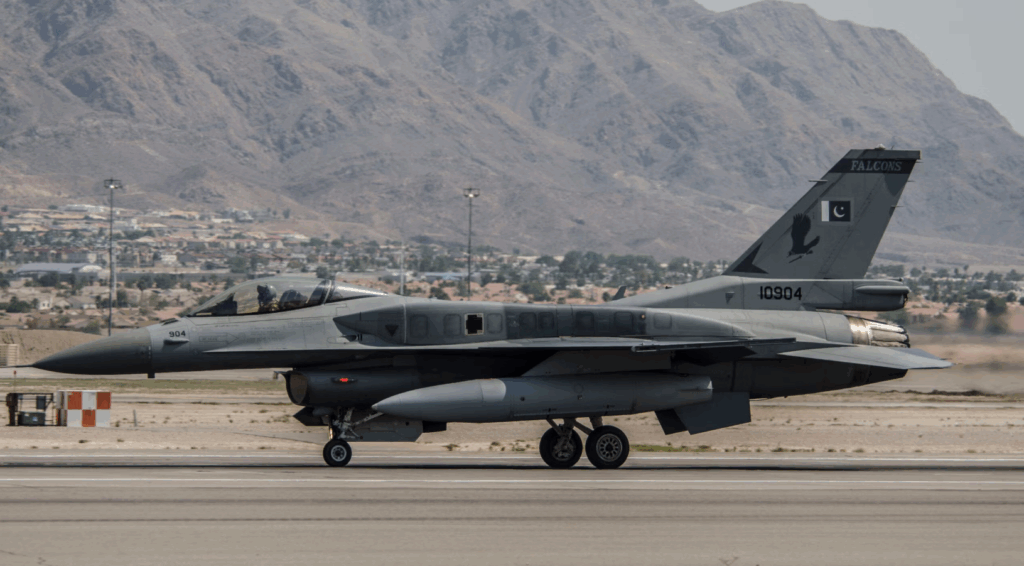By Major (R) Haroon Rasheed, Defense and Strategic Analyst, Specialist in South Asian Military Dynamics.
In a noteworthy development for Pakistan’s air defense modernization, the United States has authorized the export of its advanced AIM-120D3 air-to-air missile to more than 30 countries — and Pakistan is reportedly among them. This decision could soon enable the Pakistan Air Force (PAF) to arm its fleet of nearly 90 upgraded F-16 Block 52 fighters with one of the most sophisticated beyond-visual-range (BVR) missile systems in the world.
This move, if realized, would significantly enhance Pakistan’s air-to-air combat capabilities and restore a degree of balance in South Asia’s evolving aerial battlefield — where India’s Rafale fighters currently operate the European Meteor missile.
15 dead after landslide hits bus in Himachal’s Bilaspur
Saudi Shura Council delegation arrives in Islamabad for talks
Yousuf Gilani leads Pakistan’s delegation to 68th Commonwealth Parliamentary Conference
For more such Opinions & Blogs, click here.
A Major Upgrade for Pakistan’s F-16 Fleet
The AIM-120D3 represents the cutting edge of the AMRAAM family, boasting a range exceeding 160 kilometers, improved data link connectivity, enhanced target discrimination, and superior resistance to jamming and countermeasures. For the Pakistan Air Force, which already fields earlier AIM-120C variants, this upgrade would dramatically extend engagement range and strike flexibility.
In an era where “first look, first shot, first kill” determines the outcome of air combat, the AIM-120D3 provides Pakistani pilots the ability to engage enemy aircraft long before detection — transforming the F-16 into a true high-survivability platform in contested airspace.
Balancing Against India’s Rafales and Meteor Missiles
India’s acquisition of the Rafale fighters, equipped with Meteor missiles, initially gave the Indian Air Force (IAF) a clear advantage in long-range aerial engagements. The Meteor, with a range of around 180 kilometers and an advanced ramjet propulsion system, was considered a game-changer for regional airpower balance.
World Cotton Day being celebrated today
Interior Minister visits executive passport office in Lahore
Ayesha Ayaz wins gold & silver medals at Indonesia Taekwondo Championship
However, Pakistan has already countered this advantage through the induction of Chinese JF-17 Block III and J-10C fighters armed with the PL-15 missile — a modern Chinese long-range BVR missile with an effective range of up to 250 kilometers. While not indigenous, the PL-15 has given the PAF a formidable reach advantage, enabling it to engage threats far beyond the range of both the Meteor and the older AMRAAM variants.
Thus, the potential induction of the AIM-120D3 would not be a response born out of fear, but a strategic step to diversify and standardize PAF’s missile capability across both its Western and Chinese-origin platforms.
Strategic Implications for South Asia
1. Restoring and Sustaining Balance:
The AIM-120D3 ensures that Pakistan’s F-16 fleet remains a credible deterrent against India’s growing airpower. With the PL-15 already covering extreme long-range engagements, the D3 would strengthen Pakistan’s medium-to-long-range interception layer, closing any remaining capability gap.
2. Reinforcing Deterrence Credibility:
The 2019 Balakot episode demonstrated PAF’s precision, professionalism, and control. The integration of AIM-120D3 missiles would further enhance that deterrence by raising the cost of any future airspace violation.
Pakistan not part of any arms race with India: DG ISPR
IHC Moved to Halt Toshakhana-II Verdict Against Imran Khan and Bushra Bibi
Major Terror Plot Foiled: Huge Cache of Weapons and Explosives Seized in Mir Ali
3. Strategic Signaling by the U.S.:
Washington’s decision to include Pakistan among eligible countries for AIM-120D3 export sends a calibrated signal. While deepening its defense partnership with India, the U.S. is simultaneously ensuring that Pakistan’s defensive deterrent remains intact — preserving strategic balance in the subcontinent.
4. Operational Versatility:
Pakistan’s ability to integrate both Chinese (PL-15) and American (AIM-120D3) systems underscores its operational flexibility and diversified defense strategy. It reflects Islamabad’s success in maintaining strong ties with multiple defense partners without over-reliance on any single source.
Doctrinal and Tactical Impact
With the AIM-120D3, the PAF’s F-16 fleet would possess a decisive first-shot capability at extended ranges, especially when supported by airborne early warning systems (AEW&C) and networked radar systems. The combination of PL-15’s 250 km reach and AIM-120D3’s precision performance would allow Pakistan to cover multiple engagement zones simultaneously — establishing a layered defense against any aerial threat.
From Israel–Hamas to Pakistan’s Economy: Mubasher Lucman Breaks It Down
Judge’s Family Injured in Mysterious Fire After Ruling Against Trump Administration
Tension Escalates in Ladakh as Internet Blocked, Forces Deployed
This integration also enables Pakistan to maintain interoperability with Western systems, while retaining the long-range strike depth provided by its Chinese platforms — a balance very few air forces in the world can claim.
Conclusion
Pakistan’s potential acquisition of the AIM-120D3 missile represents a calculated and forward-looking step in strengthening national air defense. Together with the Chinese PL-15, it cements the Pakistan Air Force’s position as one of the most technically balanced and combat-ready air arms in the region.
While India’s Rafale-Meteor combination initially shifted perceptions of aerial superiority, Pakistan’s dual integration of AIM-120D3 and PL-15 ensures that no such edge can last long The message is clear: Pakistan does not fear technological advancements — it matches them with strategy, balance, and preparedness.
In the evolving chessboard of South Asian airpower, Pakistan’s strength lies not in numbers but in precision, adaptability, and resolve
For more such Opinions & Blogs, click here.
Muttaqi Leaves for Russia to Attend Moscow Format Meeting
Damaged Charger Leads to Arrest Of Key Overground Worker in Pahalgam Incident Case
France Prime Minister, resigns after less than month in office
Man Throws Shoe at Chief Justice of India in Supreme Court
Toss Controversy Hits India-Pakistan Women’s World Cup Game After Match Referee’s Error
Arbaaz Khan welcomes baby girl with Sshura Khan
Major (R) Haroon Rasheed is a defense and strategic analyst specializing in South Asian military dynamics, deterrence strategy, and defense modernization. He is a member of the Research and Evaluation Cell for Advancing Basic Amenities and Development.
Stay tuned to Baaghi TV for more. Download our app for the latest news, updates & interesting content!






